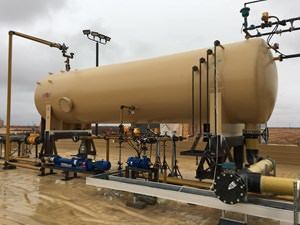What Can a Change of Direction in Saltwater Disposal Do for You?
Published on by Water Network Research, Official research team of The Water Network in Academic
For operators in the Permian basin, executing successful drilling programs hinges on an ability to manage the flowback and produced water associated with new wells coming online.
The way in which this is managed typically depends on internal water handling assets, and in many cases this responsibility is outsourced to midstream water companies. The quantity of new wells is far from the only challenge; operators must also consider the size and the production requirements for these new wells. Longer laterals require significantly more water—and sand—to frac.
Subsequently, this ends up in production and water handling facilities downstream. As more conventional saltwater disposal (SWD) facilities reach their injection capacity, the oil carryover and solids accumulation also follow the same trend. It is the known challenges with managing and treating saltwater that has led NOV to develop the Horizontal Gun Barrel (HGB) and introduce a more innovative and efficient solution to the common pain points of SWD operation.
The HGB, as the name implies, is a horizontal vessel that dramatically increases the effective removal of recovered oil from saltwater as compared to more traditional gun barrel designs. It’s long been known to production engineers and production companies that separation efficiency within a horizontal vessel far exceeds that of a vertical vessel, and the company is allowing SWD operators to capitalize on those available benefits.

Photo: NOV.
Within the HGB, water and oil travel four times the distance from inlet to outlet when compared to a vertical gun barrel. In doing so, the oil only needs to rise a very short distance before reaching the interface level. NOV is applying the same principle to improve the efficiency and profitability of saltwater disposal applications that has been used for decades in the oil and gas production space.
For many years, SWD facilities have been designed with additional offload and desanding tanks upstream of the gun barrels with the primary purpose of preventing further solids buildup downstream. The combined capital expense for adding unnecessary tanks, pumps, valves, fittings, and instruments can be substantial, and all of it is done to avoid the inevitable operational expense of tank cleanouts.
The gain in separation efficiency with the horizontal geometry is limited if the vessel fills with solids. Therefore, the HGB design has made use of a unique Tor online vessel desanding (OVD) technology to remove solids from within the vessel without negatively impacting efficiency of oil extraction. Most importantly, this technology removes solids from the facility process and injection well downstream; thus, eliminating the added expense of unnecessary equipment and tank cleanouts.
The HGB’s increased oil recovery rate, combined with solids removal capability, is allowing operators in the Permian to deploy facilities that are more cost effective to construct and more efficient to operate. With an average daily throughput of 20,000 to 25,000 BWPD, a single HGB can eliminate a conventional SWD facility’s need for offload/desanding tanks, transfer pumps, and vertical gun barrels. Although SWD operators are primarily focused on treating water prior to injection downhole, the added revenue from oil sales can be a differentiating factor and directly impact profitability.
The HGB not only increases the quantity of oil that is recovered, but also the quality of that oil. The vessel is designed to remain fluid-packed and keep a pad of oil, allowing the oil to dehydrate before being dumped to the oil sales tanks.
Read more about saltwater disposal at World Oil
Media
Taxonomy
- Oil & Gas
- Oil Field Chemicals
- Waste Disposal
- Water Disposal